Heading into the first of our monthly overview of ground-breaking, interesting, or simply quirky tech or ideas from the world of e-bikes in 2024:
This Edition . . .
E-bike Snapshot Right Now
The history of the bicycle industry really begins with the first bicycle boom in 1868, then the 1890s which saw the appearance of hoards of manufacturers and brands looking to cash in (most of whom eventually went broke). The situation today is similar, with non-bicycle companies jumping into the market, new startups hoping to get a foothold, and long established bicycle brands working hard to maintain, or increase, their market share (quite a few of whom will either go broke, the projects abandoned . . . or subsidized forever where they belong to an electronics behemoth).
The market is, thus, very crowded—competition is stiff. 2023 saw an unprecedented spate of brand bankruptcies largely caused by a cash flow squeeze resulting from the sudden and massive drop in demand following the spike in demand during the pandemic. Generally speaking, the sheer number of offerings in the market have made for an almost cut-throat environment.
To assist companies with either a innovative yet viable idea, or a product that has been proven in the market but is short of development funding, the Taipei Cycle show this year sees the launch of the inaugural Bike Venture Program for start ups and scale ups, a collaboration between Taipei Cycle and Anchor Taiwan.
Anchor Taiwan is a platform that brings together established companies, start ups and investors. The focus is not merely to support companies bringing innovative products to market, but to insert them into a supportive environment, tap into existing ecosystems or even build out an ecosystem where none exists.
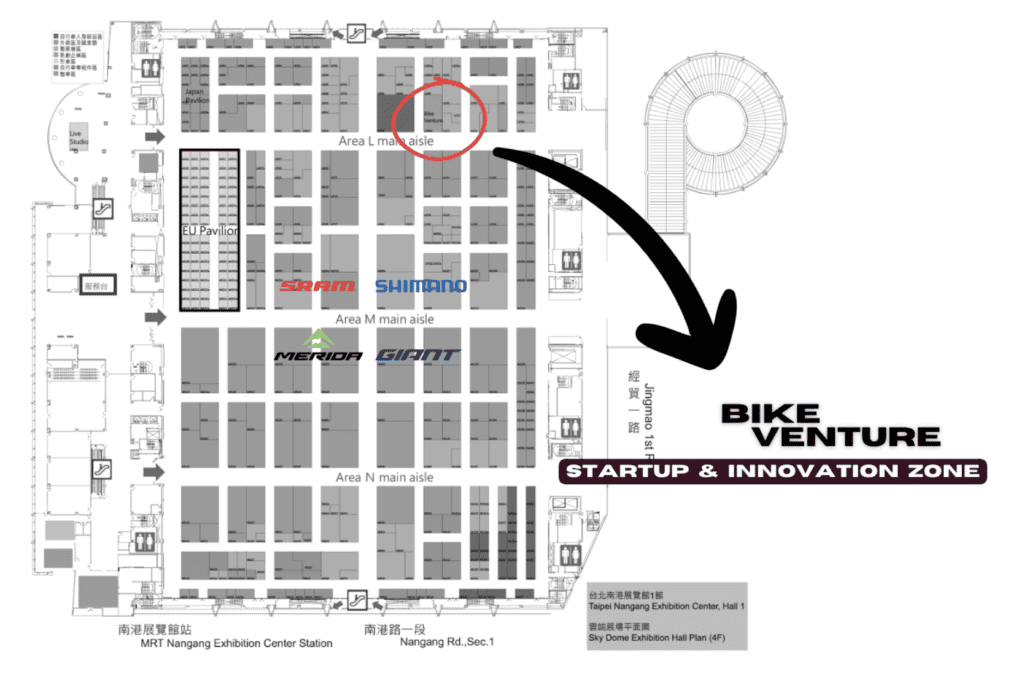
The event consists of the Bike Venture Summit, Startup and Innovation Zone, VIP Delegation, and plenty of opportunities for prospects to connect with industry decision makers and investors.
The initiative’s themes include four focus areas which could be said are the 4 pillars upon which success for any company in the bicycle niche will be based from now on:
1. Electrification
2. Digital Transformation
3. ESG Solutions
4. Disruptive Business Models.
Success will stem from providing innovative products based on innovation is each area, innovations, of course, that solve real problems for particular groups in the cycling community.
The first three are foundational and start with a broad, general focus which becomes progressively particular. The fourth is especially interesting—and especially important—and need not be just limited to “disruptive” models. That concept is more of a trendy (and perhaps increasingly vacuous) catch-phrase among business pundits these days. Keeping with the Summit’s theme, probably innovative is exactly the right word.
The Summit organizers include leasing, micro-insurance, customized services, AI and big data, metaverse, health and sport platforms as key domains in which companies could provide services. And a recognition that the real business of any company is the provision of a service or services rather than a product per se; services and not things are—or certainly must be if they are not already—the focus.
2023 Developments
Let’s take a quick look back at 2023 to prime speculation regarding where things may go in 2024 and beyond.
The current shift to electric arguably went mainstream around 10 years ago now. So it took a decade for the implications of power-assisted cycling to catch up with the sleeping giant in the form of cargo bikes—2023 was arguably the year of the cargo bike and the next two years will certainly see remarkable development in design conceptualization and technology.
Notable technological innovations in 2023 may include AWD. Yamaha have been stolidly developing e-bikes longer than just about anyone (30 years) and are set to debut an AWD bike. Yet, AWD works for vehicles which are much heavier than e-bikes. Electric assist or single wheel drive is proving more than enough in even cargo bikes where the concept makes the most sense. Their power steering initiative seems close to gimmick territory though and hardly an advance in ebike design or tech.
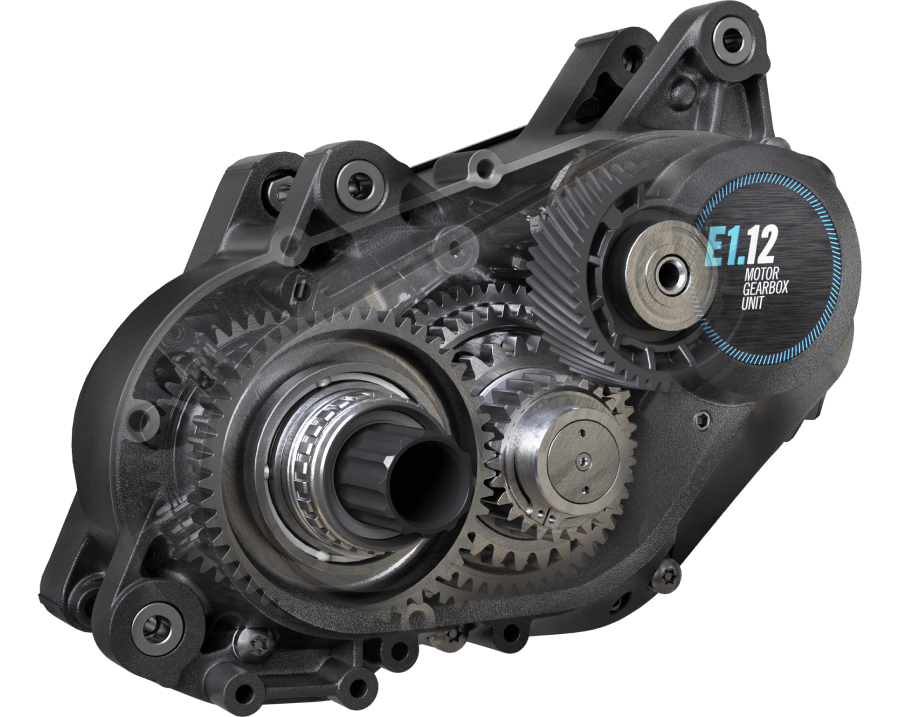
Pinion’s motor and gearbox combo was one of the highlights of the year; the rise of these products heralds the demise of the derailleur on e-bikes in the near future. Weight and expense are obstacles to wider adoption. But isn’t that the case for e-bikes in general?
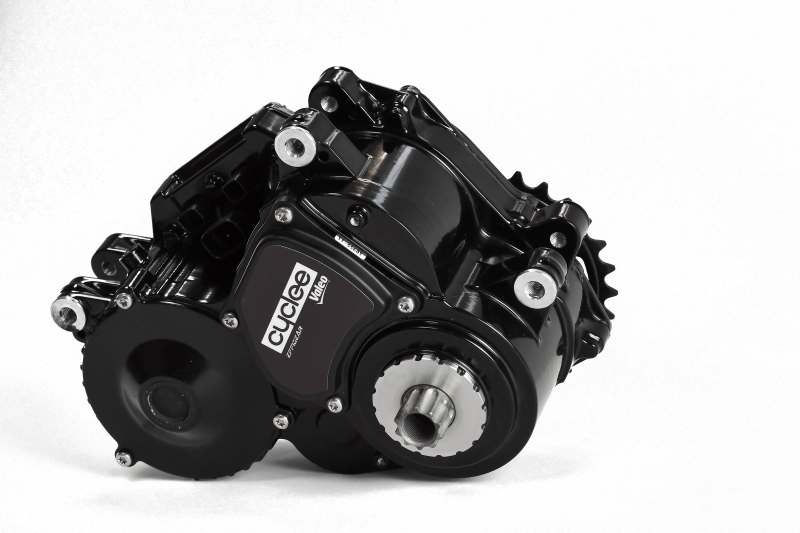
Valeo has upgraded their motor/gearbox offering incorporating the latest iteration of their HMI (Human Machine Interface), a concept which is beginning to come more into focus and appear in companies’ marketing blurb. The new HMI is a
3 component system made of a smart dock, a 2” touch display and a remote with a rotative throttle. The new HMI seamlessly transitions from city to mountain terrains, thanks to multiple assembly positions and a removable display.
Schaeffler’s Free Drive system which replaces chain or belt drives with a generator to move an e-bike appeared two years ago and is now seeing active application in cargo bike fleets. Is it going too far to see this system as possibly heralding the demise of the chain/belt drive? If so, the Pinions and Valeos will have to move quickly to incorporate gearbox functions into their own versions.
These areas will certainly be a focus for further developments over the course of 2024 and 2025. And we will watch with interest.
USA: The Prize Market is Primed for Takeoff
Up until 2023, the patchwork of state-based lawmaking has been a major inhibitor to e-bike uptake in the USA . . . that and a puzzling lack of enthusiasm on the part of the huge mass of potential consumers.
Not any more. Looking back in the future, 2023 will probably be seen as the watershed. But the lack of federal support for e-bikes compared with the EV tax credit worth up to $7,500, especially as e-bike sales are ahead of electric cars is a mystery.
Nevertheless incentives are increasingly being offered by local authorities in a variety of forms. New York—of course—is set to lead the way with the introduction of an up to 50% subsidy on the cost of a new e-bike. (Here’s how much more efficient e-bikes are compared to cars). While the total subside tops out at $1,100, which may limit the range of e-bikes a consumer may consider if price is the primary factor, 1000 big ones is going to significantly boost the number of units purchased. And at 1/3 of the average ebike price, get set for takeoff. The economies of scale accompanying this shift will ultimately put downward pressure on price points across the board and so on in a virtual circle. E-bikes will soon be absolutely everywhere.
Focus on Design
Having had a look at where we are right now, the integration of electrical into all types of vehicle does pose some problems of definition. The main problem, though, is probably the legal aspect where definitions are everything.
Defining an E-bike is Not Getting Easier
“[I]t all gets a little fuzzy as to what exactly is what … with terms like low speed electric bicycle, e-bike, motorized bicycle, moped, and pedelec, along with the terms Class 1, 2, or 3, and designs that emulate motorbikes, the landscape of two-wheeled micromobility is rather broad right now.” Cleantechnica.
Perhaps the defining complication is the addition of a throttle, eliminating any requirement to pedal. In Taiwan, for example, heavy e-bikes with throttles have been around forever and are really de facto electric motor bikes fitted with with cranks for the odd time you allow your battery to go flat. There is a move to require licenses for such bikes since they match their pedal-powered scooter counterparts in speed and acceleration albeit at a lower power threshold.
The Return of Three Wheels

Three wheelers have always existed alongside bi-cycles since the early days, two wheels at the back and one at the front at any rate, a trike in other words.
Dolas Bike has come up with, effectively, a variation on a cargo bike. Their Defender 250 is named after the three 250 watt motors—one in each wheel. Should be the Defender 750, actually. The unit is “perfect” for riders whether they want to “ride around town, cruise down bumpy roads or go on off-road adventures” they say. The two rear wheels articulate to provide suspension between them.
Seems like an analogue of the SUV in the 70s and 80s where it morphed from a niche off-road 4-wheel drive—truly off-road—to a trendy all-purpose family vehicle not well suited to either purpose. That may be an unfair comparison since in rural environments you could envisage the Defender replacing the (pickup) truck, or ute, as they call it in Australia. It would be probably be quite out of place in inner city environments where the rapidly expanding range of cargo bikes would provide exactly the right model fit for purpose.

Pinkbike’s eMTB of the year is Orbea’s Wild, no doubt a Freudian reflection of the price, which is also wild. The Wild embodies eMTB excellence right now—so sleek you can hardly tell the BB houses a powerful motor. The comments are telling, with much praise for Crestline as it happens, not just for the kit but the customer service which is absolutely crucial these days. Companies that prioritize polite, friendly, and efficient customer service will always outdo those that don’t, even where arrogant brands offer superior kit in many cases. Anyway, the Wild is a good case study of the design benchmark at the moment.
More on Batteries – Recycling | Recharging
What most e-bike riders wish to avoid is running out of power. Although that’s largely in the hands of the user in the end, batteries are getting bigger with more storage capacity. But the ESG angle is becoming urgent on the supply side pushing companies to make batteries recyclable.
Last year’s winner at Taipei Cycle’s d&I awards presented a cost-effective method for replacing individual battery cells in their batteries. If this start up can get funding and institutionalize cell replacement rather than whole battery replacement, the recycling problem may be resolved.
Until then, whole battery recycling rules and Hungryforbatteries.org is leading the way supported by PeopleForBikes and Call2Recycle. E-bike users drop off their used battery/ies at a nearby collection center; there are 1900 across the USA at the moment. Materials are recovered from each battery for reuse in new batteries.
The program is funded by participating brands—consumers can avail themselves of the initiative only if their brand is a supporter. 55 brands, including many of the heavyweights, have signed on so far.
MorphRover is an indoor exercise and fat tire e-bike that recharges its own battery. A 30 minute stationary session can power a 15 km ride afterwards. For riders so inclined, warming up beforehand and cooling down afterwards become doubly attractive.
Deliveries – E-bikes vs E-scooters
The gig economy can be demanding, demanding AND dangerous for delivery riders who are always ‘on the clock’. Having become an increasingly important element in last mile delivery ecosystems, even incremental technical innovations are important.
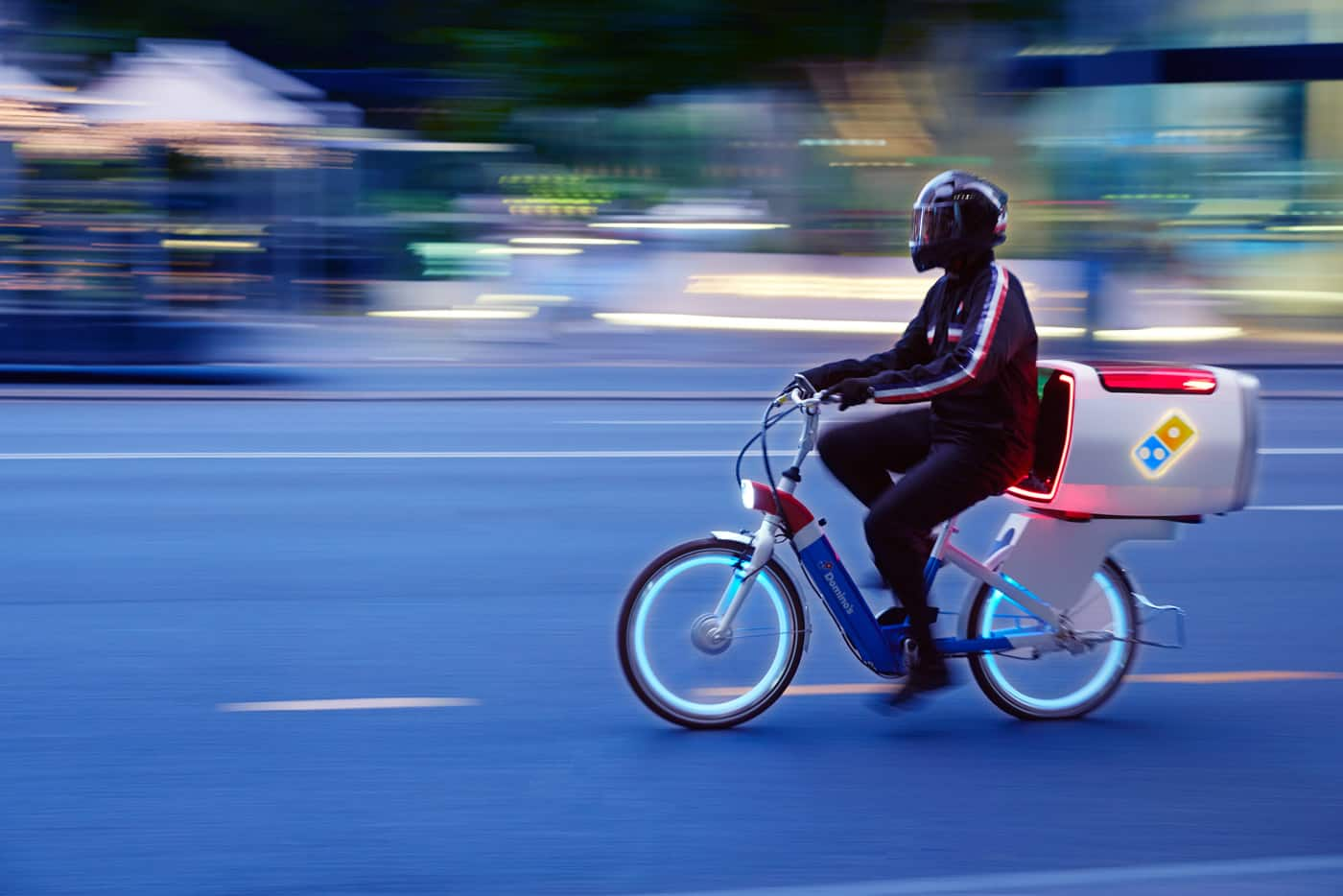
Domino’s Pizza has their DXB with mounted oven—no need to push red lights to make the cutoff where pizzas are not getting cold. What’s more each pie is crisp and dry, not soggy. The customer wins; the delivery rider wins.
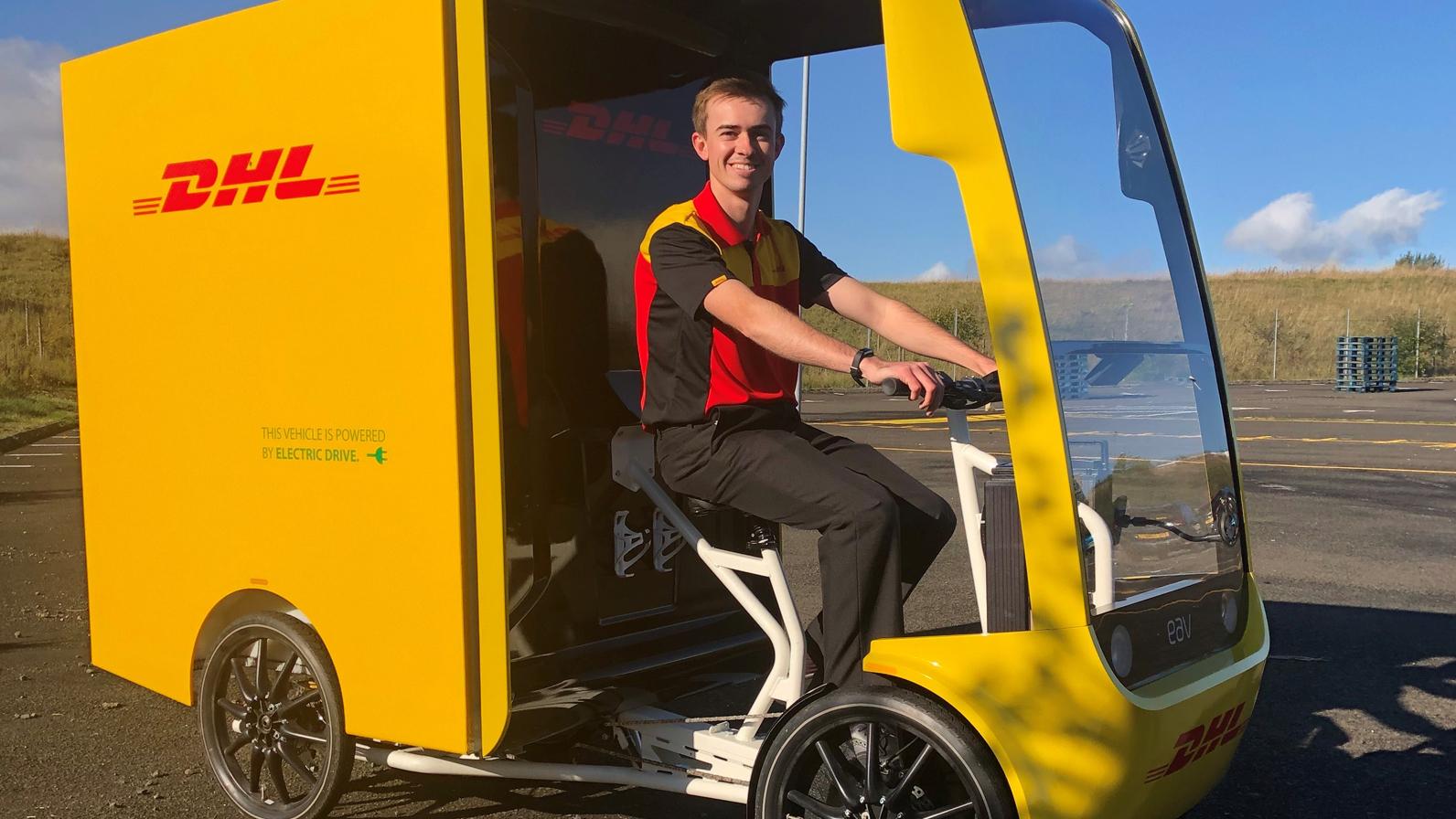
DHL are replacing vans with e-cargo bikes.
Cargo bike drive systems are evolving as a result. The SPM Module is a chainless drive slowly being adopted, particularly for the type of carriage that DHL provides—heavy loads along with heavy duty usage.
However are e-bikes the perfect delivery vehicles in light of the availability of super-efficient long range electric scooters? The latter (eg. Gogoro) are much faster in an industry where time is of the essence. Delivery riders make money by increasing their average daily revenue over time—more deliveries = higher income.

A vehicle like the Scootility cargo electric scooter is a literal scooter rather than an electric version of a 100 or 125cc petrol unit. For the heavy lifters such as DHL, it won’t do the job. But thousands of gig delivery riders would arguably substantially increase their bottom line by making the switch from pedals to all-electric.
Other Ebike Concepts of Interest
Theft is one of the two biggest obstacles to e-bike uptake by potential e-bike users.
Corratec’s new tracking technologyin collaboration with Apple is an effective attempt to address the issue of theft. Knowing where to locate your bike after the event is certainly important and opens the way to recovery. However taking action on the news won’t necessarily be easy and even risky in many cases, depending on how desperate the villains are.

The LAVO Electric Bike is a hydrogen powered, modular vehicle that can be disassembled and stored away. Great where space is at a premium perhaps. The LAVO’s electrolyzer converts electricity collected via solar panels into power which splits water into hydrogen and oxygen. The hydrogen is stored in LAVO’s patented metal hydride ready to power the bike.
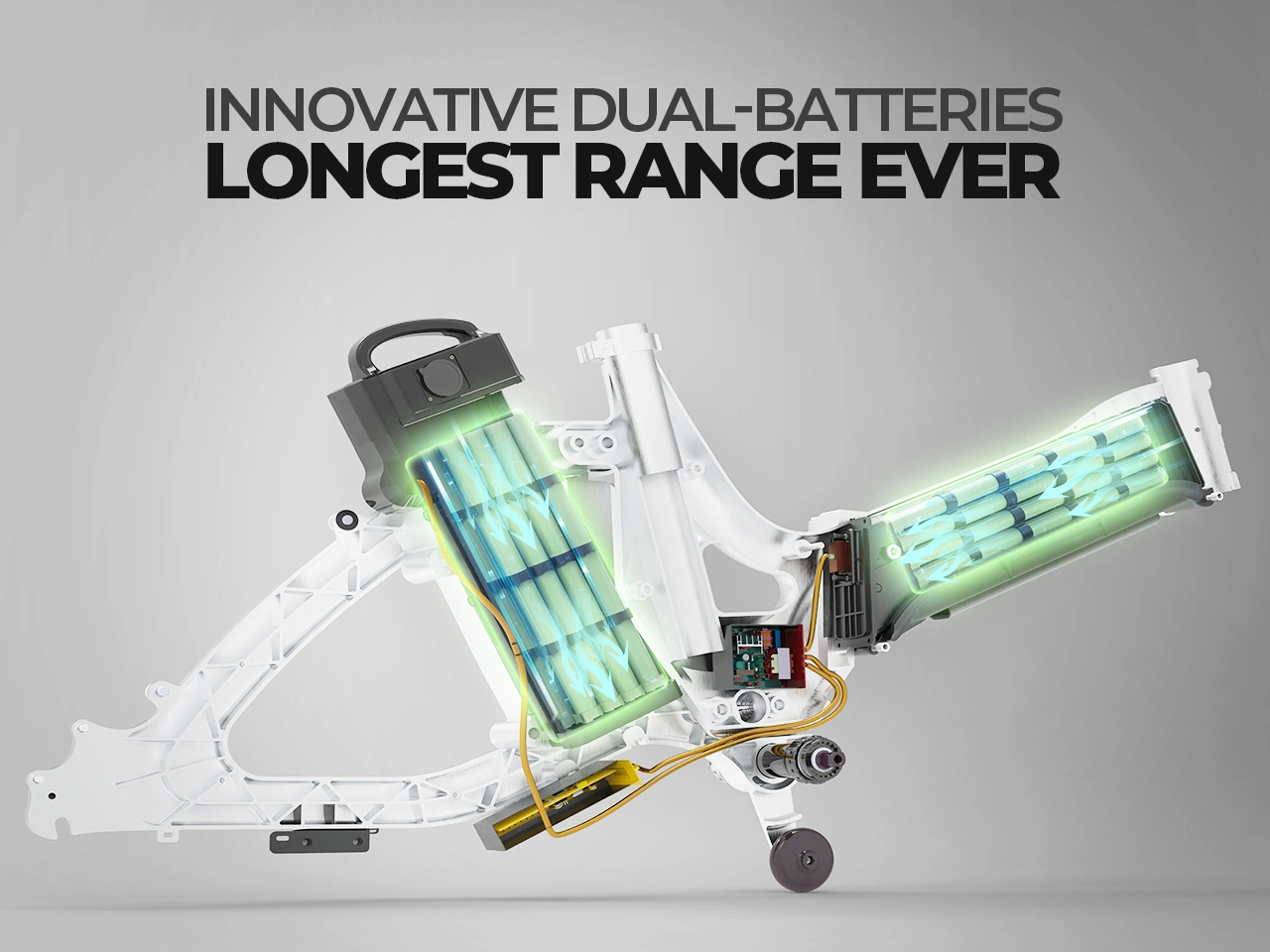
A duel battery model like no other? The Mihogo One is not yet a thing; the concept will initially be tested as a crowdfunding campaign. The combination of a foldable e-bike equipped with a massive range of 270km is mildly puzzling, although the second battery is an option—if you need the range or simply the ability to extend the period of time between charging.
